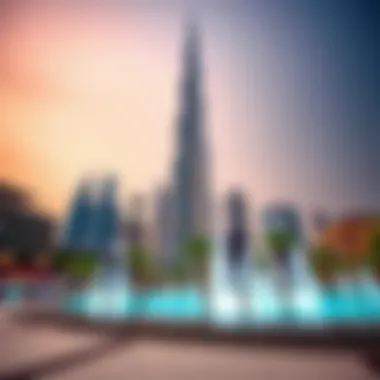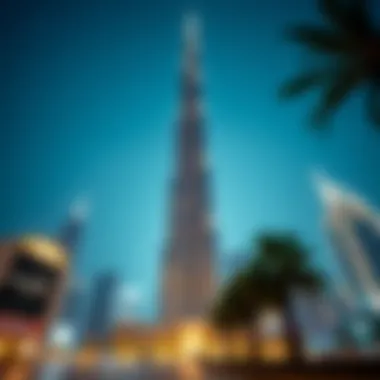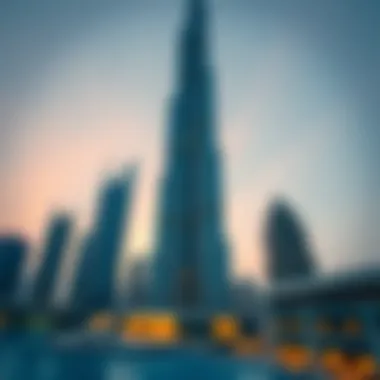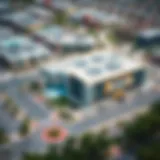Burj Khalifa: Architectural Marvel and Real Estate Impact


Intro
When one gazes up at the Burj Khalifa, the world's tallest structure, it's hard to separate sheer awe from its staggering story. Standing at a towering 828 meters, this architectural jewel has become synonymous with Dubai's rapid ascent as a global metropolis. But its significance transcends mere height; it has irrevocably reshaped the real estate landscape of the city.
Each shimmering pane of glass reflects not just the sunlight, but the ambitious vision of a nation eager to portray itself as a leader in development and innovation. In a city that literally rose from the sands, the Burj Khalifa is an emblem of what is possible—an irresistible magnet drawing tourists and investors alike. As we explore its multi-faceted influence, we will uncover how this remarkable structure has become, not just a landmark, but a catalyst for myriad market trends, economic dynamics, and property investments within Dubai.
The following segments will delve deeply into the current market conditions prompted by the presence of the Burj Khalifa—analyzing not just the here and now, but also what the future might hold. We will dissect property investment insights that can support both seasoned investors and newcomers looking to navigate this distinctive landscape fueled by a stunning architectural achievement. Let’s begin this journey into the heart of Dubai’s real estate evolution.
Prologue to Burj Khalifa
The Burj Khalifa stands as a testament to human ingenuity and ambition, soaring above the skyline of Dubai at an impressive height of 828 meters. It has not only changed the physical landscape of the city but also reshaped perceptions of what a city can represent in the context of modern architecture and lifestyle. Understanding the Burj Khalifa is essential for anyone interested in Dubai’s real estate market, as its significance extends beyond mere aesthetics; it is a catalyst for economic growth and cultural identity.
Overview of Burj Khalifa
Completed in 2010, the Burj Khalifa was designed by the architectural firm Skidmore, Owings & Merrill, with Adrian Smith being the lead designer. Its distinctive, soaring structure draws inspiration from traditional Islamic architecture, particularly the minarets commonly found in the region. The building features a series of setbacks that taper as it ascends, enhancing both its grandeur and stability. The tower hosts a blend of residential spaces, corporate offices, a hotel managed by Armani, and observation decks offering breathtaking views.
The building's lighting and design elements celebrate the UAE’s culture while integrating cutting-edge technology. It includes 57 elevators and 8 escalators, which allows for seamless movement within this vertical city. The Burj Khalifa is not just an icon; it embodies a lifestyle, attracting tourists and residents alike, while also establishing itself as an integral part of the global architectural conversation.
Historical Context
The conception of the Burj Khalifa began in the early 2000s as part of a broader ambition to transform Dubai from a desert-based economy into a significant global player in finance, commerce, and tourism. This shift was crucial in combating the region’s reliance on oil revenue. When the building finally opened its doors, it was declared the tallest structure in the world, representing a bold statement of progress and ambition.
The project faced numerous challenges, from economic fluctuations to construction hurdles, yet it persevered and became a hallmark of resilience in the face of adversity. Its placement in Downtown Dubai has contributed to the area's rapid development, turning it into an affluent center for business and entertainment.
The Burj Khalifa thus symbolizes more than mere height; it encapsulates a historical moment for the UAE, highlighting the ambitions of the emirate and the architectural shifts of the 21st century. For investors and buyers, this building is a critical barometer of real estate trends in Dubai, shedding light on future developments in this ever-evolving landscape.
"The Burj Khalifa is not just a building; it's a movement that illustrates what can happen when innovation meets determination."
Overall, grasping the Burj Khalifa’s introduction is essential for understanding the broader implications it holds for Dubai’s identity and economic future.
Architectural Design and Engineering
The Burj Khalifa isn’t just a skyscraper; it represents a steps in the art of architecture and engineering. This section looks into the intricacies behind its monumental structure, showcasing how every line drawn and every material chosen have led to this iconic edifice dominating the Dubai skyline. Understanding architectural design and engineering is crucial as it highlights the challenges overcome and the innovative solutions implemented. These aspects are not only important for the structure’s aesthetics but also for its functionality and sustainability, which in turn affect its economic viability in Dubai's booming real estate market.
Design Inspiration
The architectural design of the Burj Khalifa draws heavily from Islamic architecture, notably the minarets found in traditional mosque structures. The building’s overall form is derived from the Hymenocallis flower, symbolizing beauty and fluidity in design. This botanical inspiration is not merely superficial; it reflects an understanding of how nature can inform and enhance man-made structures.
Consequently, the tower features a Y-shaped floor plan that provides structural stability while allowing for spectacular views of the city and the surrounding desert. The design isn’t just for show; its geometry plays a critical role in reducing wind loads on the building, which is essential for a structure reaching such heights. The 360-degree view from the observation decks, combined with the aesthetic grace of the structure, offers both tourists and investors alike a solid reason to appreciate its innovative design.
Moreover, this fascinating blend of cultural references and modern engineering ensures that the Burj Khalifa is not only a feast for the eyes but also functional and efficient. It symbolizes the cultural aspirations of Dubai while being firmly rooted in the region's heritage.
Construction Techniques
Building the Burj Khalifa was no small feat. Utilizing advanced construction techniques, the engineers tackled numerous hurdles associated with the extreme height. A core-based structural system was adopted, which is crucial for handling the forces acting on the building. The reinforced concrete used provides a strong and stable foundation, promoting endurance against the ever-changing weather conditions in Dubai.
An innovative jump form system was employed, enabling crews to efficiently pour concrete at great heights, while also ensuring precise and timely completion. This method greatly expedited the construction process, allowing the building to be completed in just over six years. Workers also utilized high-tech cranes and machinery that seemed to defy gravity, a sight that astounded many who watched the structure rise.
"Innovation is the key to transforming challenges into advancements."


Such advanced methodologies underscore not only the engineering prowess displayed in the Burj Khalifa's construction but also set a precedent for future developments. The techniques apply not only to Dubai but to global urban development, making them invaluable to architects and engineers worldwide.
Materials and Sustainability
In today's world, sustainability is not just an option but a necessity, especially for significant structures like the Burj Khalifa. The building features over 103,000 square meters of glass, designed to minimize heat absorption while maximizing natural light—thus reducing energy consumption. The choice of materials was also based on their capability to withstand Dubai's harsh climate while offering minimal environmental impact.
Additionally, the Burj Khalifa's water system demonstrates innovation with straightforward yet effective solutions. It uses a re-circulating water system that efficiently collects and utilizes water runoff from the building. This highlights a commitment to sustainable practices in construction while reducing the overall ecological footprint.
Key materials like high-strength concrete and aluminum were chosen not only for their durability but also for their relevance to local resources enhancing local economies through job creation. Ultimately, these sustainable practices not only showcase architectural advancement but also reflect a growing awareness of environmental responsibility in the real estate sector.
In summary, the architectural design and engineering behind Burj Khalifa serve as pillars of both innovation and tradition. With influences from the natural world, cutting-edge construction techniques, and a robust commitment to sustainability, this skyscraper emerges as a beacon of architectural excellence. It’s not just the tallest building in the world; it’s a model for what can be achieved when vision meets technology and care for our environment.
Cultural and Economic Impact
The Burj Khalifa stands as more than just a towering structure; it is a pivotal force in shaping both the cultural identity and economic landscape of Dubai. This section delves into how this architectural edifice influences tourism, stimulates local business growth, affects real estate pricing, and enhances global branding for the city it proudly graces.
Burj Khalifa and Tourism
Visitor Experiences
When it comes to experiencing the Burj Khalifa, visitors find themselves immersed in a world of awe and splendor. One of the most striking aspects of the visitor experience is the observation deck on the 148th floor, which boasts breathtaking panoramic views of the city and surrounding desert. This vantage point allows tourists to see far and beyond—a view that can hardly be matched anywhere else on the planet. The sheer thrill of standing atop the tallest building in the world ignites a unique sense of achievement for many visitors. This appealing feature positions the Burj Khalifa as a must-visit attraction, making it a popular choice for tourists seeking unforgettable experiences in Dubai.
However, it's not merely the height that draws people in; the experience is augmented by advanced digital displays and interactive exhibits that offer insights into the building's remarkable construction and Dubai's rich heritage. This mix of architecture, technology, and culture captivates and educates visitors, giving them a sense of connection to the city and its vision. Though some might argue that the ticket prices can be in the higher range, the experience often outweighs the cost, providing value for those looking to create lasting memories.
Local Business Growth
The presence of Burj Khalifa has fundamentally transformed the local business landscape. As tourists flock to the site, many local enterprises thrive. Restaurants, retail shops, and service providers in the vicinity benefit remarkably from the influx of visitors. This boom nurtures not only large businesses but also small startups that find it easier to engage with a diverse clientele.
A standout point is the collaboration between the Burj Khalifa management and local businesses, which often boosts joint promotional activities, drawing in crowds and ensuring that everyone wins. For instance, many food outlets near the base have tailored their offerings based on the varied tastes of tourists coming from all corners of the globe. Such adaptive measures can lead to enhanced customer satisfaction and repeat business.
Despite the apparent advantages, challenges persist, especially for smaller businesses struggling to navigate the competitive landscape created around this monumental structure. Rising rental costs and increased marketing needs can strain resources, making it essential for local entrepreneurs to continually innovate while balancing costs.
Influence on Real Estate Prices
As one would expect from such an iconic landmark, the Burj Khalifa has a profound impact on real estate prices across Dubai. Properties in its immediate vicinity have seen substantial appreciation. Buyers and investors eagerly seek real estate around this area, as many perceive proximity to the Burj as a hallmark of prestige and luxury. This phenomenon has led to a noticeable increase in property values, resulting in a blossoming market ripe for investment.
However, this growing demand comes with its own set of challenges. While some welcome the rise in property values, others are concerned about affordability for local residents, hinting at a widening gap between those who can purchase property and those who cannot. Amidst this fluctuating landscape, understanding market trends becomes crucial for investors and buyers alike.
Global Recognition and Branding
When you mention the Burj Khalifa, you’re likely referring to more than just a building; it’s an icon known worldwide, contributing significantly to Dubai's brand. Its image frequently graces everything from travel brochures to major film productions, indicating its role as a key player in global tourism marketing. The visual appeal of the Burj, especially with its shimmering glass facade, enhances Dubai's attractiveness as a premier travel destination.
This level of branding, however, comes with responsibilities. Keeping the structure and surrounding areas well-maintained is essential to not just preserving its beauty, but also sustaining the city’s brand integrity. Moreover, as the global architectural landscape continues to evolve, the Burj Khalifa faces competition and must continually innovate to maintain its allure, ensuring it remains a relevant symbol for both Dubai and the broader real estate market.
In summation, the Burj Khalifa's impact on Dubai extends well beyond its elegant silhouette, weaving itself into the very fabric of the city’s cultural and economic identity. It stirs the tourism engine, propels local business growth, affects real estate dynamics, and enhances Dubai's global image—making it a cornerstone of the city’s ongoing evolution.
Burj Khalifa in the Context of Dubai's Skyline
The Burj Khalifa stands as a beacon of architectural prowess and economic ambition in Dubai's skyline. Its towering height and unique design not only redefine the city’s aesthetic but also influence its real estate landscape. This section dives into how Burj Khalifa integrates into the broader architectural fabric of Dubai and what that means for various stakeholders, such as investors, expats, and property buyers.
Comparison with Other Structures


When examining the Burj Khalifa, one cannot overlook the comparisons it invites with other global landmarks. While it towers over structures like the Shanghai Tower and the Abraj Al Bait Clock Tower, it does more than just reach for the sky. For instance, the Burj Khalifa is not just about height; it symbolizes the aggressive push of Dubai to assert itself as a world leader in architecture and tourism.
- Height vs. Design: The Burj Khalifa is sleek and contemporary, capturing light and altering how the city is viewed. Unlike the more utilitarian Shanghai Tower, its design reflects the delicate interplay between art and engineering.
- Cultural Significance: Where other skyscrapers like One World Trade Center enlighten on resilience, the Burj Khalifa focuses on transcendence, representing not merely a building but a lifestyle.
Moreover, as other cities scramble to construct taller buildings, they face a crucial question: can mere height create lasting appeal? The answer appears clear as the Burj Khalifa continues to draw tourists and investors alike.
Future Developments
Looking forward, the Burj Khalifa is more than just a landmark; it is a catalyst for ongoing and future developments in Dubai. Other skyscrapers are in the pipeline, creating a competitive yet synergistic atmosphere.
- New Projects: For instance, projects like the Dubai Creek Tower aim to outshine the Burj Khalifa in height, which might shift the architectural landscape in the coming years. However, the lessons learned from building the Khalifa could set standards for future projects, especially concerning sustainability and design integrity.
- Economic Growth: Furthermore, with infrastructure projects such as the expansion of the Dubai Metro and improvements in transportation accessibility, the area surrounding Burj Khalifa will likely see a spike in property values and rental prices. Investors are keenly observing how future developments align with Dubai’s ambitious Urban Development Strategy.
"Burj Khalifa is not just a structure; it’s a dynamic element reshaping Dubai’s future, from real estate to tourism."
In summation, the Burj Khalifa serves both as an iconic structure and a transformative influence on Dubai’s urban environment. As it continues to inspire new architectural endeavors, its presence will profoundly affect cultural and economic trajectories for years to come.
Living and Working in Burj Khalifa
Living and working in the Burj Khalifa is not just about the stunning skyline view; it’s about embracing a lifestyle that merges luxury, convenience, and innovation. The building stands tall as a beacon of modern architecture, offering a unique blend of residential and commercial spaces that cater to the needs of today’s urban dwellers and business professionals. Its significance extends beyond aesthetics, shaping the social fabric of Dubai while influencing its real estate landscape.
Residential Offerings
The residential units within the Burj Khalifa are designed for those with a taste for the finer things in life. Ranging from one to four-bedroom apartments, these living spaces are the epitome of sophisticated living, featuring stunning interiors and state-of-the-art appliances. Residents benefit from a plethora of amenities, including:
- 24/7 concierge services: Always at hand, they assist with everything from personal requests to maintenance needs.
- Access to swimming pools and gyms: Multiple shared spaces, including an outdoor pool and a health spa, illustrate the luxurious lifestyle that residents can expect.
- Sky lounge and observation decks: As if the view of the city wasn’t enough, residents have access to exclusive areas that are perfect for entertaining guests or simply enjoying the breathtaking scenery.
One downside to keep in mind is that living in such an iconic building often comes with higher living costs, which may not suit everyone’s budget. However, for those who prioritize luxury and prestige, the investment can be well worth it.
Commercial Spaces
The Burj Khalifa is also home to numerous commercial spaces that accommodate a variety of businesses. From high-end boutiques to top-tier corporate offices, the tower is designed to meet diverse commercial needs. Major highlights include:
- Prime Location: Situated in the heart of Dubai, the Burj Khalifa allows businesses to be in proximity to key financial and tourist destinations.
- Prestigious Address: Operating from such a remarkable structure enhances brand visibility and enhances corporate image, attracting both clients and customers.
- Innovative Work Environment: The tower houses flexible office spaces that promote collaboration, creativity, and convenience among the workforce.
Businesses operating within Burj Khalifa benefit from foot traffic, especially considering it attracts massive crowds of tourists. This dynamic creates ample opportunities for commerce and networking.
The End on Living and Working in Burj Khalifa
Living and working in the Burj Khalifa is fundamentally intertwined with the identity of Dubai's real estate landscape. Its offerings are tailored for a select demographic that cherishes exclusivity and innovation. As real estate in Dubai continues to evolve, the Burj Khalifa stands as a benchmark of what urban living and working should aspire to be.
For more details on real estate trends or to understand more about living in Dubai, check out Dubai Property or visit Wikipedia for Burj Khalifa.
Visiting Burj Khalifa
Visiting Burj Khalifa is not just about standing beneath the tallest building in the world; it represents an encounter with a landmark that embodies architectural prowess and cultural significance. Tourists and locals alike are drawn to this towering wonder, eager to experience its breathtaking views and vibrant atmosphere. Understanding how to navigate this iconic site enhances one’s experience, showcasing both its grandeur and the practical elements that facilitate a smooth visit.
Visitation Guidelines
When planning a visit to Burj Khalifa, it’s vital to be aware of the guidelines that govern entry and exploration of this iconic skyscraper. Tickets can be purchased online in advance, which is a smart way to avoid long queues. It’s recommendable to choose the time of day for your visit wisely; sunset slots are particularly popular due to the stunning views they offer. Ensure to arrive early for security checks, which can take some time, especially during peak tourist seasons.
• Tickets: Purchase online for the best chance at securing your preferred time slot. • Timing: Consider visiting during weekdays for less crowd. • What to Bring: A fully charged phone or camera is a must—pictures from the observation deck are sure to impress.


The observation deck is located on the 148th floor, standing at a staggering height of 555 meters. Apart from just the ride up, a guided tour is available, offering insights into the architectural brilliance and technological aspects behind Burj Khalifa. Visitors must also adhere to safety protocols, as the sheer height introduces controls for crowd management.
Special Events and Light Shows
Burj Khalifa hosts numerous special events and captivating light shows throughout the year, further enriching the visitor experience. The spectacular display of lights and colors against the building’s facade provides something for everyone, appealing to both sightseers and photography enthusiasts. One of the most popular events is the New Year’s Eve fireworks display, which attracts thousands eager to witness this dazzling spectacle.
Additionally, during various cultural celebrations, the building often turns into a canvas for artistic light shows, with themes reflecting local customs and festivals. Each show is carefully choreographed, transforming the facade into a lively, ever-changing artwork that captivates audiences below.
For those who wish to enhance their visit, many events also involve music, adding another layer of enjoyment to the visual feast. Guests should check the official Burj Khalifa website or local event calendars to stay updated on upcoming shows and celebrations to make the most of their visit.
Remember: Special events often draw large crowds, so plan ahead if you wish to participate in any.
Burj Khalifa: A Symbol of Innovation
The Burj Khalifa stands tall not just as the tallest building in the world but also as a beacon of innovation. Its creation speaks volumes of human ambition, merging art and technology into a singular entity that reshapes both skyline and perception. The significance of Burj Khalifa extends beyond its physical height; it represents a confluence of creative genius and cutting-edge engineering, setting a precedent for future architectural endeavors.
Architectural Innovations
When discussing architectural innovations, Burj Khalifa takes center stage as a trailblazer in several ways. One of its most striking features is the design, which draws inspiration from Islamic architecture, notably the geometric patterns found in traditional minarets. This aesthetic is not merely superficial; it plays a functional role in distributing structural load across its stepped back profile, allowing the building to reach its astounding height of 828 meters.
The use of a ‘buttressed core’ structure is another innovative feature. This method involves a central concrete core that provides stability and is supported by three wings that radiate outward. This unique design helps minimize wind loads by channeling gusts around the building, a crucial consideration for such towering constructs. In application, the Burj Khalifa’s design demonstrates a balance between artistic expression and practical integrity, embodying both form and function.
Moreover, the tower incorporates advanced materials. The exterior is clad in reflective glazing, stainless steel, and a façade that consists of over 103,000 square meters of glass. This not only enhances its visual appeal but also helps in temperature regulation, reducing energy costs for heating and cooling inside the structure. Consequently, these innovations render Burj Khalifa not just a skyscraper but an entity that can adapt to the ever-changing demands of its environment.
"The Burj Khalifa is a transformation of ideas and dreams into a monumental reality, showcasing what is possible when creativity meets technology."
Technological Advancements
In terms of technological advancements, Burj Khalifa is packed with features that redefine what is possible in skyscraper construction. One of the most vital systems utilized in the building is the integrated Building Management System (BMS), which ensures efficient operations across various aspects such as climate control, security, and energy management. This system allows for real-time monitoring and quick adjustments, ensuring a smooth experience for the occupants.
Safety is another area where Burj Khalifa shines. The building is equipped with an impressive fire safety system that includes a comprehensive array of sprinkler systems, smoke detectors, and pressurized stairwells. With the height of the building, conventional safety measures are hardly sufficient, hence specialized technology has been implemented for rapid and effective emergency response—this extends to the design of elevators too, which are some of the fastest in the world.
Elevators are a feat of engineering, enabling swift vertical transport within the skyscraper. The double-decker elevators can travel at speeds of up to 10 meters per second, handling a high volume of commuter traffic with remarkable efficiency.
In summation, the Burj Khalifa epitomizes the quintessence of innovation in architecture and construction. It marries traditional design elements with cutting-edge technologies, setting a gold standard for skyscrapers globally. These innovations not only enhance its status as a must-see landmark but also significantly contribute to the economic and social landscape of Dubai, making the Burj Khalifa a monumental symbol of what humanity can achieve.
Finale
The conclusion of our exploration into the Burj Khalifa provides an essential synthesis of its impact on Dubai's real estate landscape and its architectural significance. This iconic structure is not simply the tallest building in the world; it represents the pinnacle of modern engineering and design aesthetics. With every glass panel that shimmers under the Middle Eastern sun, the Burj Khalifa projects a narrative of ambition, resilience, and innovation.
The Lasting Legacy of Burj Khalifa
The Burj Khalifa's legacy is multi-faceted. Firstly, it has become a symbol of Dubai's rapid development and diversification away from traditional oil reliance. As a beacon of modernization, it has attracted international attention and sparked inquiries from investors eyeing the Emirate for lucrative opportunities. Its presence has indeed been a boon for the tourism sector, providing a magnificent attraction that increased foot traffic to nearby businesses, hotels, and retail outlets.
Moreover, the architectural techniques employed in constructing the Burj Khalifa have affected global design practices, pushing boundaries further than ever before. Innovations in skyscraper construction, thermal performance, and energy efficiency used here serve as templates for future high-rise projects worldwide. In essence, the Burj Khalifa is not just a structure; it has become part of the collective consciousness and an enduring reference point in the world of architecture and urban development.
Future Perspectives
Looking forward, the Burj Khalifa stands at a crossroad of opportunity and challenge. As cities around the globe begin to grapple with sustainability and urban density, the lessons learned from the construction and operation of this monumental tower will inform the next generation of urban architects and city planners. The vertical city paradigm, emphasized in Burj Khalifa, could potentially redefine living and working spaces in metropolitan areas.
In a broader sense, as Dubai contemplates its post-pandemic recovery, the Burj Khalifa will continue to play a pivotal role in shaping perceptions—and realities—of safety, luxury, and lifestyle in urban living. The real estate market, while influenced by global trends, will look to the Burj Khalifa as a key indicator of desirability and value in residential and commercial sectors.
"The Burj Khalifa exemplifies not just what is possible, but what is achievable when innovation meets ambition.”
For more comprehensive insights into Dubai’s architectural progress, visit Wikipedia or the Encyclopedia Britannica.
Additionally, real estate professionals can get up-to-date information on market trends from platforms like Reddit and various property investment guides.











